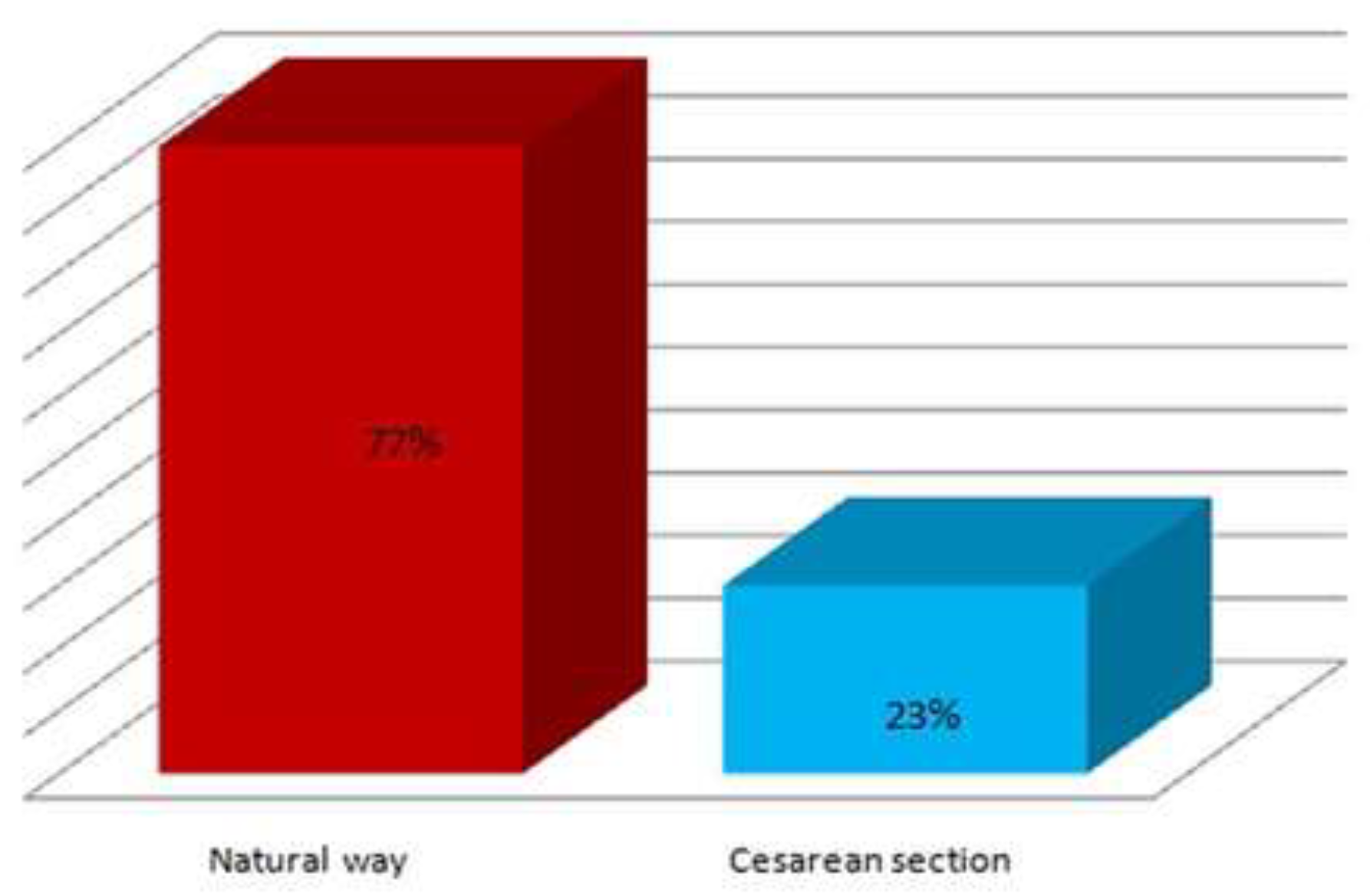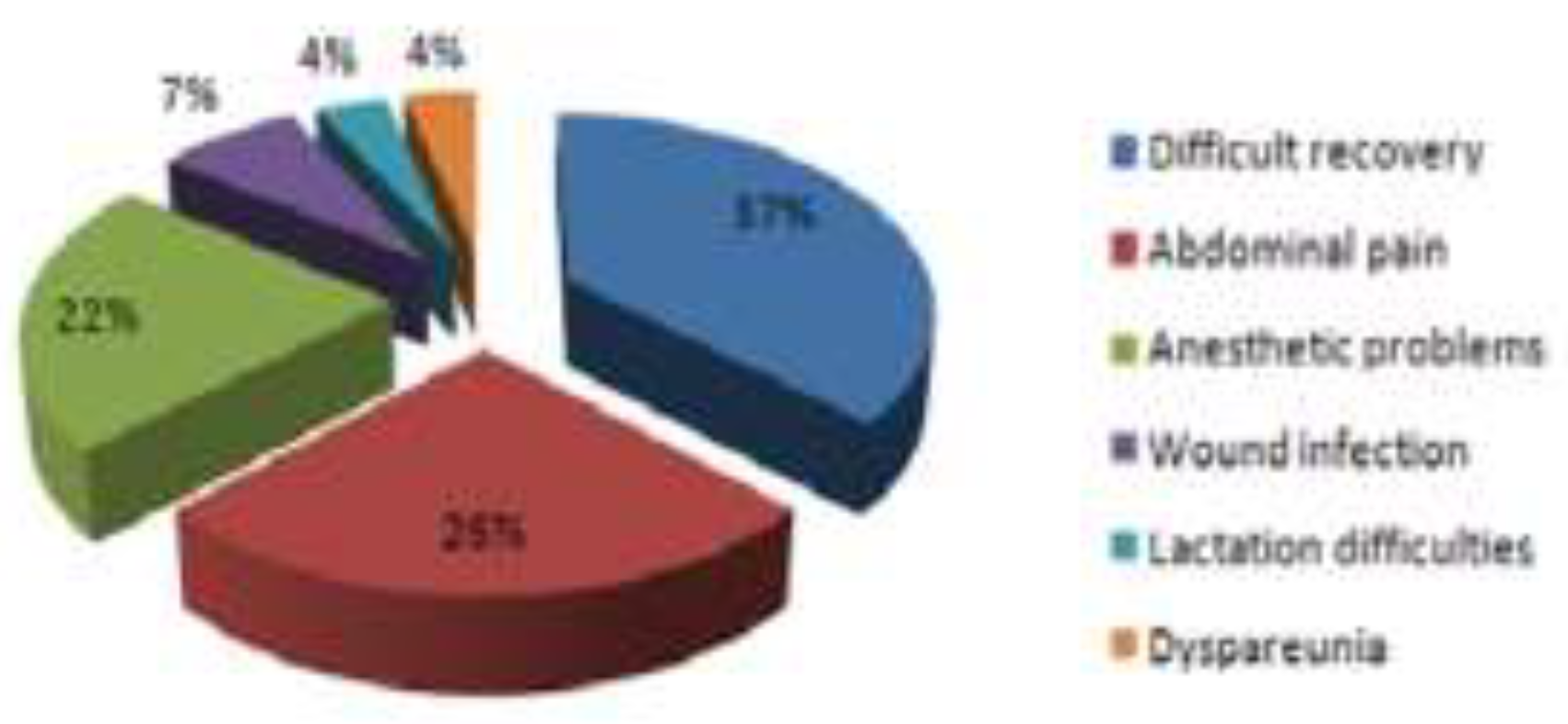Caesarean Section Versus Vaginal Birth in the Perception of Woman Who Gave Birth by Both Methods
Abstract
:Introduction
Materials and Methods
Statistical analysis
Results
Discussions
Conclusions
Conflict of interest disclosure
Compliance with ethical standards
Authors’ contributions
References
- Dimitriu, M.; Ionescu, C.A.; Matei, A.; Viezuina, R.; Rosu, G.; Ilinca, C.; Banacu, M.; Ples, L. The problems associated with adolescent pregnancy in Romania: A cross-sectional study. J Eval Clin Pract. 2019, 25, 117–124. [Google Scholar] [CrossRef] [PubMed]
- Stoll, K.H.; Hauck, Y.L.; Downe, S.; Payne, D.; Hall, W.A.; International Childbirth Attitudes-Prior to Pregnancy (ICAPP) Study Team. Preference for cesarean section in young nulligravid women in eight OECD countries and implications for reproductive health education. Reprod Health. 2017, 14, 116. [Google Scholar] [CrossRef] [PubMed]
- Erasun, D.; Alonso-Molero, J.; Gómez-Acebo, I.; Dierssen-Sotos, T.; Llorca, J.; Schneider, J. Low birth weight trends in Organisation for Economic Co-operation and Development countries, 2000-2015: Economic, health system and demographic conditionings. BMC Pregnancy Childbirth. 2021, 21, 13. [Google Scholar] [CrossRef]
- Keag, O.E.; Norman, J.E.; Stock, S.J. Long-term risks and benefits associated with cesarean delivery for mother, baby, and subsequent pregnancies: Systematic review and meta-analysis. PLoS Med. 2018, 15, e1002494. [Google Scholar] [CrossRef] [PubMed]
- Betran, A.P.; Torloni, M.R.; Zhang, J.; Ye, J.; Mikolajczyk, R.; Deneux-Tharaux, C.; Oladapo, O.T.; Souza, J.P.; Tunçalp, Ö.; Vogel, J.P.; Gülmezoglu, A.M. What is the optimal rate of caesarean section at population level? A systematic review of ecologic studies. Reprod Health. 2015, 12, 57. [Google Scholar] [CrossRef] [PubMed]
- Harrison, M.S.; Pasha, O.; Saleem, S.; Ali, S.; Chomba, E.; Carlo, W.A.; Garces, A.L.; Krebs, N.F.; Hambidge, K.M.; Goudar, S.S.; Kodkany, B.; Dhaded, S.; Derman, R.J.; Patel, A.; Hibberd, P.L.; Esamai, F.; Liechty, E.A.; Moore, J.L.; Wallace, D.; Mcclure, E.M.; Miodovnik, M.; Koso-Thomas, M.; Belizan, J.; Tshefu, A.K.; Bauserman, M.; Goldenberg, R.L. A prospective study of maternal, fetal and neonatal outcomes in the setting of cesarean section in low-and middle-income countries. Acta Obstet Gynecol Scand. 2017, 96, 410–420. [Google Scholar] [CrossRef]
- Pang, M.W.; Leung, T.N.; Lau, T.K.; Hang Chung, T.K. Impact of first childbirth on changes in women’s preference for mode of delivery: Follow-up of a longitudinal observational study. Birth. 2008, 35, 121–128. [Google Scholar] [CrossRef] [PubMed]
- Boatin, A.A.; Schlotheuber, A.; Betran, A.P.; Moller, A.B.; Barros, A.J.D.; Boerma, T.; Torloni, M.R.; Victora, C.G.; Hosseinpoor, A.R. Within country inequalities in caesarean section rates: Observational study of 72 low and middle income countries. BMJ. 2018, 360, k55. [Google Scholar] [CrossRef] [PubMed]
- Ples, L.; Sima, R.M.; Carp, D.; Alexandroaia, C.; Balalau, D.O.; Stanescu, A.D.; Olaru, O.G. The psychosocial impact of vaginal delivery and caesarean section in primiparous woman. J Mind Med Sci. 2018, 5, 70–74. [Google Scholar] [CrossRef]
- Bălălău, O.D.; Olaru, O.G.; Dumitru, V.; Păunică, I.; Stănescu, A.D. Maternal infections with an increased risk of transmission to the foetus; a literature review. J Clin Invest Surg. 2020, 5, 66–72. [Google Scholar] [CrossRef]
- Deng, W.; Klemetti, R.; Long, Q.; Wu, Z.; Duan, C.; Zhang, W.H.; Ronsmans, C.; Zhang, Y.; Hemminki, E. Cesarean section in Shanghai: Women’s or healthcare provider’s preferences? BMC Pregnancy Childbirth. 2014, 14, 285. [Google Scholar] [CrossRef]
- Ye, J.; Zhang, J.; Mikolajczyk, R.; Torloni, M.R.; Gülmezoglu, A.M.; Betran, A.P. Association between rates of caesarean section and maternal and neonatal mortality in the 21st century: A worldwide population-based ecological study with longitudinal data. BJOG. 2016, 123, 745–753. [Google Scholar] [CrossRef] [PubMed]
- Saisto, T.; Halmesmäki, E. Fear of childbirth: A neglected dilemma. Acta Obstet Gynecol Scand. 2003, 82, 201–208. [Google Scholar]
- Eide, K.T.; Morken, N.H.; Bærøe, K. Maternal reasons for requesting planned cesarean section in Norway: A qualitative study. BMC Pregnancy Childbirth. 2019, 19, 102. [Google Scholar] [CrossRef]
- Pang, M.W.; Leung, T.N.; Lau, T.K.; Hang Chung, T.K. Impact of first childbirth on changes in women’s preference for mode of delivery: Follow-up of a longitudinal observational study. Birth. 2008, 35, 121–128. [Google Scholar] [CrossRef]
- Finger, C. Caesarean section rates skyrocket in Brazil. Many women are opting for caesareans in the belief that it is a practical solution. Lancet. 2003, 362, 628. [Google Scholar] [CrossRef]
- Alexandroaia, C.; Sima, R.M.; Balalau, O.D.; Olaru, O.G.; Ples, L. Patients’ perception of childbirth according to the delivery method: The experience in our clinic. J Mind Med Sci. 2019, 6, 311–318. [Google Scholar] [CrossRef]
- Bălălău, O.-D.; Bacalbașa, N.; Olaru, O.G.; Pleș, L.; Stănescu, D.A. Vaginal birth after cesarean section—Literature review and modern guidelines. J Clin Invest Surg. 2020, 5, 13–17. [Google Scholar] [CrossRef]
- Ross-Davie, M.; McElligott, M.; King, K.; Little, M. Midwifery support in labour: How important is it to stay in the room? Pract Midwife. 2014, 17, 19–22. [Google Scholar]
- Motofei, I.G.; Rowland, D.L.; Georgescu, S.R.; Tampa, M.; Paunica, S.; Constantin, V.D.; Balalau, C.; Manea, M.; Baleanu, B.C.; Sinescu, I. Post-Finasteride Adverse Effects in Male Androgenic Alopecia: A Case Report of Vitiligo. Skin Pharmacol Physiol. 2017, 30, 42–45. [Google Scholar] [CrossRef]
- Sigurdardottir, V.L.; Gamble, J.; Gudmundsdottir, B.; Kristjansdottir, H.; Sveinsdottir, H.; Gottfredsdottir, H. The predictive role of support in the birth experience: A longitudinal cohort study. Women Birth. 2017, 30, 450–459. [Google Scholar] [CrossRef] [PubMed]
- Maputle, M.S. Support provided by midwives to women during labour in a public hospital, Limpopo Province, South Africa: A participant observation study. BMC Pregnancy Childbirth. 2018, 18, 210. [Google Scholar] [CrossRef]
- Cetisli, N.E.; Arkan, G.; Top, E.D. Maternal attachment and breastfeeding behaviors according to type of delivery in the immediate postpartum period. Rev Assoc Med Bras (1992). 2018, 64, 164–169. [Google Scholar] [CrossRef] [PubMed]
- Zaręba, K.; Banasiewicz, J.; Rozenek, H.; Wójtowicz, S.; Jakiel, G. Peripartum Predictors of the Risk of Postpartum Depressive Disorder: Results of a Case-Control Study. Int J Environ Res Public Health. 2020, 17, 8726. [Google Scholar] [CrossRef]
- Ye, J.; Zhang, J.; Mikolajczyk, R.; Torloni, M.R.; Gülmezoglu, A.M.; Betran, A.P. Association between rates of caesarean section and maternal and neonatal mortality in the 21st century: A worldwide population-based ecological study with longitudinal data. BJOG. 2016, 123, 745–753. [Google Scholar] [CrossRef] [PubMed]
- Bălălău, O.D.; Bacalbașa, N.; Stănescu, A.D. Caesarean scar defects and placental abnormalities: A three-year survey study. J Mind Med Sci. 2017, 4, 156–162. [Google Scholar] [CrossRef]
- Yang, Q.; Wen, S.W.; Oppenheimer, L.; Chen, X.K.; Black, D.; Gao, J.; Walker, M.C. Association of caesarean delivery for first birth with placenta praevia and placental abruption in second pregnancy. BJOG. 2007, 114, 609–613. [Google Scholar] [CrossRef]
- Bălălău, O.D.; Bacalbașa, N.; Bălălău, C.; Negrei, C.; Gălățeanu, B.; Ghinghină, O.; Răduță, C.; Pleș, L.; Stănescu, A.D.; Dumitru, V.A. The correlation between histopathological and ultrasound findings regarding Caesarean section scars—A three-year survey study. J Mind Med Sci. 2019, 6, 143–149. [Google Scholar] [CrossRef]
- Walker, S.P.; McCarthy, E.A.; Ugoni, A.; Lee, A.; Lim, S.; Permezel, M. Cesarean delivery or vaginal birth: A survey of patient and clinician thresholds. Obstet Gynecol. 2007, 109, 67–72. [Google Scholar] [CrossRef]
- Leung, A.S.; Leung, E.K.; Paul, R.H. Uterine rupture after previous cesarean delivery: Maternal and fetal consequences. Am J Obstet Gynecol. 1993, 169, 945–950. [Google Scholar] [CrossRef]
- Bălălău, O.D.; Sima, R.M.; Bacalbașa, N.; Pleș, L.; Stănescu, A.D. Emergency peripartum hysterectomy, physical and mental consequences: A 6-year study. J Mind Med Sci. 2016, 3, 65–70. [Google Scholar]
- Stănescu, A.D.; Bălălău, O.D.; Pleș, L.; Paunica, S.; Bălălău, C. Postpartum depression: Prevention and multimodal therapy. J Mind Med Sci. 2018, 5, 164–168. [Google Scholar] [CrossRef]
- Pană, M.; Sima, R.-M.; Bălălău, O.-D.; Stănescu, A.-D.; Pleş, L.; Poenaru, M.-O. The quality of sexual life after vaginal surgical interventions. J Mind Med Sci. 2020, 7, 201–205. [Google Scholar] [CrossRef]
- Balalau, C.; Voiculescu, S.; Motofei, I.; Scaunasu, R.V.; Negrei, C. Low dose tamoxifen as treatment of benign breast proliferative lesions. Farmacia. 2015, 63, 371–375. [Google Scholar]
- Morlando, M.; Sarno, L.; Napolitano, R.; Capone, A.; Tessitore, G.; Maruotti, G.M.; Martinelli, P. Placenta accreta: Incidence and risk factors in an area with a particularly high rate of cesarean section. Acta Obstet Gynecol Scand. 2013, 92, 457–460. [Google Scholar] [CrossRef]


© 2008 by the author. 2008 Octavian Gabriel Olaru, Anca Daniela Stanescu, Cristina Raduta, Liana Ples, Adriana Vasilache, Nicolae Bacalbasa, Andrei Vasilache, Oana Denisa Balalau
Share and Cite
Olaru, O.G.; Stanescu, A.D.; Raduta, C.; Ples, L.; Vasilache, A.; Bacalbasa, N.; Vasilache, A.; Balalau, O.D. Caesarean Section Versus Vaginal Birth in the Perception of Woman Who Gave Birth by Both Methods. J. Mind Med. Sci. 2021, 8, 127-132. https://doi.org/10.22543/7674.81.P127132
Olaru OG, Stanescu AD, Raduta C, Ples L, Vasilache A, Bacalbasa N, Vasilache A, Balalau OD. Caesarean Section Versus Vaginal Birth in the Perception of Woman Who Gave Birth by Both Methods. Journal of Mind and Medical Sciences. 2021; 8(1):127-132. https://doi.org/10.22543/7674.81.P127132
Chicago/Turabian StyleOlaru, Octavian Gabriel, Anca Daniela Stanescu, Cristina Raduta, Liana Ples, Adriana Vasilache, Nicolae Bacalbasa, Andrei Vasilache, and Oana Denisa Balalau. 2021. "Caesarean Section Versus Vaginal Birth in the Perception of Woman Who Gave Birth by Both Methods" Journal of Mind and Medical Sciences 8, no. 1: 127-132. https://doi.org/10.22543/7674.81.P127132
APA StyleOlaru, O. G., Stanescu, A. D., Raduta, C., Ples, L., Vasilache, A., Bacalbasa, N., Vasilache, A., & Balalau, O. D. (2021). Caesarean Section Versus Vaginal Birth in the Perception of Woman Who Gave Birth by Both Methods. Journal of Mind and Medical Sciences, 8(1), 127-132. https://doi.org/10.22543/7674.81.P127132


